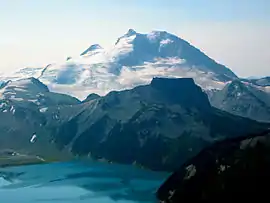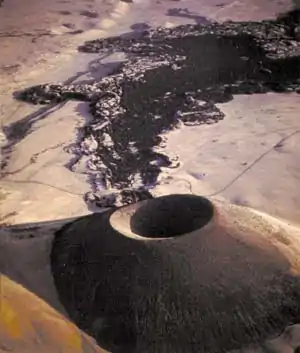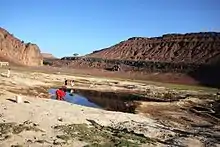Volcanic field
A volcanic field is an area of the Earth's crust that is prone to localized volcanic activity. They usually consist of clusters of 10 to 100 volcanoes such as cinder cones. Lava flows may also occur. They may occur as a monogenetic volcanic field or a polygenetic volcanic field.

Description
Alexander von Humboldt observed in 1823 that geologically young volcanoes are not distributed uniformly across the Earth's surface, but tend to be clustered into specific regions. Young volcanoes are rarely found within cratons, but are characteristic of subduction zones, rift zones, or in ocean basins. Intraplate volcanoes are clustered along hotspot traces.[1]
Within regions of volcanic activity, volcanic fields are clusters of volcanoes that share a common magma source.[2] Scoria cones are particularly prone to cluster into volcanic fields, which are typically 30–80 kilometers (19–50 mi) in diameter and consist of several tens to several hundred individual cones. The unusually large Trans-Mexican Volcanic Belt has nearly 1000 cones covering an area of 60,000 square kilometers (23,000 sq mi).[3]
Examples



Canada
- Atlin Volcanic Field, British Columbia
- Desolation Lava Field, British Columbia
- Garibaldi Lake volcanic field, British Columbia
- Mount Cayley volcanic field, British Columbia
- Tuya Volcanic Field, British Columbia
- Wells Gray-Clearwater volcanic field, British Columbia
- Wrangell Volcanic Field, Yukon Territory
United States
- Boring Lava Field, Oregon
- Central Colorado volcanic field, Colorado
- Clear Lake Volcanic Field, California
- Coso Volcanic Field, California
- Indian Heaven, Washington
- Jemez Mountains, New Mexico
- Latir volcanic field, New Mexico
- Marysvale Volcanic Field, Utah
- Raton-Clayton volcanic field, New Mexico
- San Bernardino Volcanic Field, Arizona
- San Francisco volcanic field, Arizona
- San Juan volcanic field, Colorado
- Taos Plateau volcanic field, Taos County, New Mexico
- Trans-Pecos Volcanic Field, Texas
- Wrangell Volcanic Field, Alaska
Others
- Aguas Zarcas volcanic field, Alajuela, Costa Rica
- Auckland volcanic field, North Island, New Zealand
- Bayuda Volcanic Field, Sudan
- Bombalai Hill, Sabah, Malaysia
- Central Skåne Volcanic Province, Sweden
- Chaîne des Puys, Auvergne, France
- Cu-Lao Re Group, Vietnam
- Haruj, Fezzan, Libya
- In Teria volcanic field, Algeria
- Laguna Volcanic Field, Philippines
- Manzaz volcanic field, Algeria
- Meidob Volcanic Field, Sudan
- Nemours-Nedroma, Algeria
- Oujda volcanic field, Morocco
- Oulmés volcanic field, Morocco
- Rekkame volcanic field, Morocco
- Todra volcanic field, Niger
- Vulkan Eifel, Germany
References
- Schmincke, Hans-Ulrich (2003). Volcanism. Berlin: Springer. pp. 17–19. ISBN 9783540436508.
- "Volcanic Fields". Capulin Volcano. National Park Service. Retrieved 27 October 2020.
- Schmincke 2003, p.100
See also
- Volcanic arc – A chain of volcanoes formed above a subducting plate
- Volcanic belt – A large volcanically active region
